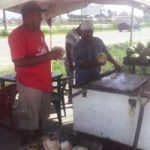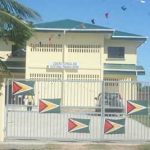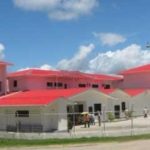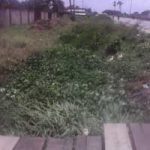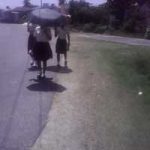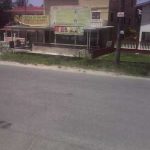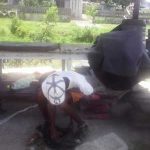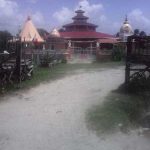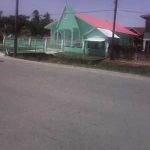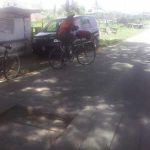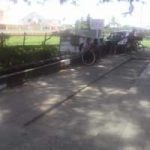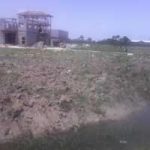The logies are just a memory…
Now a splendid village of modern homes and thriving businesses and friendly residents
WITH urging from some residents who are avid followers of our weekly Village Focus column, we decided to visit the somewhat simple, but appealing village of Leonora, nestled nicely between neighbouring Anna Catherina and Cornelia Ida (more popularly referred to as CI)
Some residents there were very reserved and refrained from speaking to the media, but those that we interacted with told varying interesting tales of the history of the village, its evolvement and its current vibrant signs of economic development.
Leonora, originally called Plantation Leonora, is situated some nine miles from Vreed-en-Hoop on the West Demerara.
The name Leonora is Dutch coming from the time of Dutch occupation of the country. It originated from the names of two Dutch children, a boy named Leo and a girl named Nora.
Leonora encompasses an area of some five square miles, and was once part of the Parish of St. Luke. It stretches from Edinburgh in the east to Stewartville in the west. It goes north as far as the Atlantic Ocean and south as far as the conservancy.
Leonora is in Region 3, part of West Coast Demerara. Its subdivisions are Pasture, Sea Field, Para Field, Groenveldt and Sear Spray. The village before Leonora is Anna Catherina and the village after is Uitvlugt.
This village has three religious groups: Hindus, Muslims, and Christians. Each group practices its religion, and shares in its religious practices without prejudice. Several villages in Guyana are of historical significance in one-way or the other, some greater than some, and others whose very existence provides solace to those who may have golden memories. Leonora is such a place, and no attempt to delve into its history would go without reward.
History
In the olden days, it used to be referred to as Plantation Leonora, and is situated some nine miles from Vreed-en-Hoop. This once busy plantation, as history tells us, was a hive of economic activities mainly because of the presence of a sugar estate where most people on the plantation and even from surrounding villages were employed. It was once graced with a railway station until the railway was disbanded in the 1970’s. Still standing are the police station, a Muslim mosque and a Hindu temple.
There is also a post office, which serves the entire district and surrounding areas, while a cinema was always there providing entertainment, prior to the coming of television. Leonora also has two schools, a secondary and a primary, which were built during the 1960’s. These schools cater now for children from the entire West Demerara area. The old Lenora Secondary School is now in ruins and was replaced not so long ago by a spanking multi-million dollar facility through Government efforts. This new institution offers academic and vocational opportunities for youths of Leonora and those from surrounding villages.
There is also a Cottage Hospital, which is today manned by a doctor and trained nurses. There is also a very large market which does very brisk business on Saturdays, when people from far off areas go and hawk their goods and do shopping.
In this West Coast Demerara village where an old sugar estate existed, has been transformed into a housing scheme. Government, however, has tried as far as possible to retain the historical significance of the estate. The sum of $85M was earmarked for the development of approximately 240 house lots in Leonora.
The majority of the Leonora population today seems to be young and may not have ready information on the rich history of the village. But village elder and very camera shy Looknauth Persaud did divulge information that was helpful.
According to this resident, the now much modernised Leonora was more of a sugar plantation during the ‘logie time’.He recalls the era when most of the population lived in logies (long ranges built by the owners of the sugar estate to house the indentured labourers who worked on the estate).
From 1821 until it was closed down in mid-December 1986, Leonora estate changed its proprietors, attorneys and administrators several times. In 1821, the proprietor and attorney was George Rainey who served in that capacity until 1871, when the estate was taken over by Sandbach Parker and Company, a name we are all familiar with because of their store in Georgetown, and William Russell became the manager. Sandbach Parker and Company was the proprietor until 1969, when they sold out to Jessel, another British company. Prior to the Jessel take-over, the administration changed hands periodically, starting in 1905 with the Administrative Manager being Mr. G. E. Anderson. He was assisted with the running of the entire estate with the help of ‘white Overseers’ who supervised works in the cane fields.
He was succeeded by Mr. A. E. Bratt in 1920, who, 10 years later, in 1930, was succeeded by Mr. Mr. R. E. Rodes, who gave way to Mr. Laiwood in 1934. After serving for 11 years, he was succeeded by Mr. R. H. Barnwell in 1945. Mr. W. O. B. Rhigden, who took over in 1951, did not last long, and made way for Mr. Gregory, who, also after one year at the helm, was superseded by Mr. E. H. Kingston. Kingston was followed by Mr. Mr. J. V. Ryder, who took over in 1957 and served exactly 10 years before handing over to Mr. Balford in 1967.
They were all Administrative Managers of the estate until Mr. Jessel bought over and made this post extinct, for the work of the Administrative Manager was taken over by the Personnel Officer. The Overseers were also relieved and their work was taken over by locals, who were known as Field Clerks. As mentioned before, the labour force on the estate was supplied by indentured labourers who were brought to the then British Guyana from India and other countries. Upon arrival on the estate, they were housed in the logies, which were divided into rooms. They all lived in one bloc or community on the estate. Yes, they were estate people.
The accommodation was so designed to have easy access to the labourers, the majority of whom worked in the cane fields from dawn to dusk. Also, by having them together, it was easy for effective management and control over them. This kind of accommodation also offered the immigrants a special incentive in their being able to see each other as much as it was possible, and to solder a social and brotherly relationship. To satisfy the ‘white man’, whose ambition was to get as much as possible out of the labourers, it was necessary to secure their health. For this purpose, a hospital was built in 1868, just next to the sugar factory.
The two-flat building, which had a doctor and dispenser, had 23 beds for males and 18 for females on the first floor, while on the upper floor there was a male ward with 57 beds. All food, hospital clothing and medicine were supplied free by the estate. The hospital was maintained until 1968, when it was demolished and the materials given for the construction of the Leonora Government School, now Leonora Primary School. Workers now seek medical attention from the estate’s dispensary and the Government Cottage Hospital.
Their dwelling was sandwiched between the sugar factory, which was to their west, and the elaborate official “white man” compound in which were housed the mansions of the Administrative Manager, other managers and the overseers, with conditions par excellence, perhaps missing only the snow they were accustomed to in England. They were positioned to offer ready assistance if anything went wrong in the factory and which warranted their immediate labour or presence. And it was from under the gargantuan saman trees of this “pond,” this “garden,” this “citadel” that the most earth-shaking, exciting and spine chilling stories were told by the older folks who took turns in the nightly event which drew a larger gathering every evening. Indeed it was from under these trees, that `jumbie’, `old higue’, Anancy and other stories were narrated.
Our informant reminisced on the period when it was a nightly ritual to see the older folks, especially men with their `bottle lamps’ and black tobacco, and in some cases jute bags on which they sat, heading under the trees close to their abode. Children kept their distance by staying home in the ‘logie’ seeking sanctuary. Apart from the fear that would have been driven into them by the stories, it was the general rule that in those days it was a taboo for children to be seen in the company of the older men. The story-tellers would even tell you stories about their day’s encounter in the backdam. Whether false or true, when these macabre tales were told, they were enough to drive fear in the bravest of the brave among the audience.
They would tell stories about how they confronted the alligator with the golden tooth and the alligator with the golden crown, and how it was better if one wanted to live, to stay clear of the canals in which they had been seen. They would also tell stories about the dangers of being under the silk cotton tree, especially at noon, because, as legend would have it, it was under those trees that the Dutch, who once occupied Guyana, loved to roam after death (Dutch jumbies). They also told gripping stories of `Dutch jumbies’ breaking the necks of children and even adults.
With an almost toothless smile, Mr. Persaud recalled how the women folk, too, took their turn in the mornings after preparing lunch and doing other chores. They, however, were involved in a kind of `talk show’, for everybody’s business was being discussed. Yes, it was from under those very trees that the private lives of others were revealed. The women were the judge, jury and executioner, all in one.
Apart from the estate location in those days, Leonora was also made up of Groenveldt and pasture. These two areas stretched mainly along the public road, and away from the sugar estate. The rest of land that made up the area of Leonora was used as pastures, rice plots and limited farmlands. As time went by, the estate allowed some of the labourers to cultivate rice on the plots and to do limited farming. But today, things have changed, and all those rice plots and pastures have made way for housing schemes which today house offspring of those very labourers who gave their lives for `king sugar’.
In 1821, there were 395 slaves on the sugar plantation. This number rose to 430 in 1832. After the slaves came the indentured and non-indentured immigrants from Calcutta, Madras, China, Africa and Madeira. The indentured immigrants were the East Indians and Chinese, who at that time numbered about 717. The non-indentured immigrants from Calcutta, Madras, China, Africa and Madeira amounted to 450. This was the population at that time that formed the core of the labour force, with the exception of the Chinese who took to business.
These were the days when the entire plantation was a single unit, for everyone lived as one big family. But as time passed, everyone became the creature of the age in which he lived, and the population, that beautiful mix that was beyond reproach, gradually drifted to other neighbouring districts and left the area which has since become a predominantly Indo-Guyanese one.
The labour force at the factory, however, remained multi-racial until its closure. Since the estate’s closure in 1986, most of the factory workers have gained employment at Uitvlugt estate and elsewhere, while the field workers were retained to continue with the harvesting of sugar cane and other fieldwork. In the 1940’s and 1950’s, Leonora Estate was a classic example of unity in diversity, especially in the sugar factory and other key areas of operation, including the garage (workshop), the pure water supply system, the electrical and the maintenance sections among others.
Indeed, it might be fair to point out that it was during those two decades that the people of Leonora propelled themselves to the top of the local map, with their prowess in various sport events, politics and their ingenuity in keeping all sections of the estate’s operations functioning at full capacity. The people were so glued to the estate and their tasks, that several initiatives to have them divorced from the job met with equal resentment, and only death could have parted them from their “empire.”
Yes, this was the mettle from which the people were made. This was their demonstration of love and pride for their job that meant everything to them. The sugar estate was their final bastion. These were the people, who, from their homes could tell whether something was going wrong at the factory only by hearing the fluctuating sounds of the machines instead of the “soothing rhythm” they were so accustomed hearing day and night
These were the men, among whom were Messrs. Nain Singh, Karmalie, Merchant, Bisnauth, Beharry, Leander and Hyman. There were also Parker and the other sea punt men who braved the Atlantic transporting sugar from Leonora to Georgetown by sea in wooden punts, driven only by sail, until they became captains of the motor driven barges which later replaced the wooden punts, and many, many others whose toil and sweat were reflected in the millions of tons of sugar that were manufactured during their time on the estate.
Children, especially boys, started working at a very tender age in order to help improve the economic situation of their parents. They took to what was called the “creole gang,” which was a gang of mainly boys, who fetched earth for building ‘stop offs,’ bail cane punts and those who served as ‘battu boys’ to white overseers and managers. The ‘batu boys’ were like male servants to their bosses, and their job entailed cleaning boots, running errands, grooming the mules for their bosses and lead and follow the mules as the case may be, while the bosses ride.
The adult labour force in the fields were divided into gangs, of which there were many including the shovel gang, weeding gang, cane cutting gang and jobbing gang, each headed by a ‘driver’ (local supervisor). Apart from the cane cutters, these categories of field workers worked from 6 am to 5 pm daily, with the most highly paid female worker receiving about $1.50 per week.
Strikes were prohibited, and agitators were restricted from crossing estate boundaries. In addition, no one was allowed to be absent from duty, unless he or she was sick in hospital or was in prison. All functions were held on Sundays which were usually non-working days. As times went by, conditions both in the field and the logies progressively worsened and field workers had to drink impure water from the middle walk (canals) in the backdam. In order to prevent epidemics, workers frequented the hospital at weekends to swallow their dose of cascara and salts, a mixture that was always plentiful at the hospital.
So the people toiled for hours unending, only to come home to their logies, and latrines that were built across trenches for both men and women. There was no privacy in logie life, but for those people, survival was very important. They suffered silently, they cried silently and they endured silently, but with cautious optimism, they stuck to their routine day in and day out. The swelling of the logie population was beginning to pose a serious problem for the estate’s authorities, and conditions were getting worse and logie life was, with each passing day, becoming a nightmare. Trade union and political leaders, including late President Dr. Cheddi Jagan, soon took up the workers’ fight, and together, with local leaders, the struggle had begun in earnest.
By this time, several changes had taken place, and workers had won the right to strike for better wages and conditions of work, or for any grievance they may encounter while working. As the struggle for better working and living conditions intensified, so did the struggle for trade union recognition, that is, a union of the workers’ choice. But the struggles over the years were not without their toll.
Indeed it was during the struggle for trade union recognition, that Kowsilla (Alice) was run over and killed by an estate tractor in March of 1964. She was among scores of other stalwarts engaged in a squatting exercise by the factory bridge for recognition of the Guyana Agricultural and General Workers’ Union (GAWU) when she was murdered. Others, mainly women, jumped into the middle walk and elsewhere to avoid being driven over by the tractor. Many sustained injuries, but the death and injuries were not in vain, for today the majority of sugar workers are represented by GAWU., the union of their choice.
As living conditions in the logies became increasingly unacceptable, strong representations were made to the authorities, and after some time, the first housing scheme was established at Seafield in the 1950’s, and the workers were granted loans from the Sugar Industry Labour Welfare Fund (SILWF), and for the first time the dismantling of the logies started at Leonora. Housing schemes were also established at Para Field and Pasture, all in Leonora, and also in neighbouring Stewartville, to accommodate some of the logie people from Leonora. While most of the older people who have built these houses have already died, the houses are now taken over by their children and their grand children.
For them, it is just getting it on the “silver platter.” But they are proud to be the offspring of those fighters who gave their lives to satisfy the white man’s desires.
Leonora today
Today, Leonora is divided into several areas where there are comfortable houses, streets, potable water and electricity. Apart from Groenveldt and pasture, there are also Sea Field, Para Field and Sea Spray, all gracing the beautiful landscape of Leonora. Bulging with a population of mostly youth today, the people freely practise their religion and cultural preferences without interference.
Unlike the days of indentureship, today, most of the younger people are urged by their parents to turn to education. The older people were not keen in those days to educate their children because of the belief that they could have returned to their motherland any time. Another important consideration was that they feared their children would have been doctrinated into Christianity. Not so today. Education is uppermost in the minds of most of the young people, and some have already made great achievements.
Today not a single ‘logie’ can be seen in Leonora. (At least I did not find any)
The village has now taken on an ambience of bustling activity and this is induced by the fact that many businesses have sprung up there.
Posh houses have replaced the yester-year structures and paved streets lend a very modern aura to the village. In most areas, there are well-maintained irrigation canals and drainage trenches, many variety stores, groceries, boutiques, salons and other entities.
The needs of villagers are met inside the settlement, since they can fulfil their desires for fashion, beauty care, household items, food and the other necessities of life right within their village.
A walk through the village will showcase businesses like Chris Tyre Shop and Auto Store, Miracle Optical, Star Cars Auto Spares, V & P Supermarket, One Stop Variety Store, and an Igloo Ice-Cream Parlour.
There is also the A & A Travel Service, High Glow Fashions, Flo J Taxi, the Islamic Library and Research Centre (now under renovation), the Factory Fresh Snackette, and of course the PPP Branch Office. This is however just a percentage of the businesses that have sprung up in the village.
Our arrival and interaction with the people
As the mini-bus ploughed its way amongst heavy morning traffic along the West Demerara Public Road, I gulped in great s of fresh country breeze and smiled lazily as a green blur of lush rice fields, foliage and idly grazing animals rushed by.
In every village we passed during our journey there was the appealing, and pleasant spectacle of residents rushing about on daily errands. In the roadside shops there were semi-large gatherings ensuring that they accessed their daily kitchen supplies, young men were either liming by the roadside on chatting joyously at roadside taxi bases that seemed to be a highpoint in the West Demerara District.
All around everyone was quietly going about their chores with a serious look of concentration on their faces as if their lives depended on the tasks they were involved in.
The tailor was sewing quietly, humming his favourite lullabies, and the fishermen were plying their trade, all ready to pitch in a few extras to keep their customers. Food vendors were doing their best to keep their customers satisfied and the shop and boutique owners were all cherry and welcoming, with a sweet undercurrent to it.
We stopped at a nearby food stall to chat with the cheery and bubbly Chaitram who was elated to be the target of media personalities. While he was very happy with the dividends he was receiving from selling water coconuts, channa, pouluri, egg balls and puri, he however let on that bountiful sales were mostly seasonal and influenced by his networking of new customers
“Me ah duh dis business fuh ovah seven years now and it ah mine me and de family. But nah everday is Christmas. Most times de sales ah really good, but sometimes things does be bad, because of the change of de people cash flow. But wan thing meh larn over de years is that the more custamos me accumulate, de betta fuh me…. Because is then dis wuk does pay off real nice…”
Fish mongol Bisham Singh is a merry contented soul, despite the fact that his trade of selling bush fish can be a gruelling one at times. “Bass dis wuk wah me does do is really hard wuk, but it ah keep meh surviving. Most times early marning me does get up and guh down in de back dam with me castnet fuh catch bush fish in dem drains and trench. Sometime me gat fuh feel in de drains fuh catch dem hassa, this is very dangerous, since snake and alligator does mek them home in plenty ah dem trench sar. But dis is how me does mek me living suh, me gah fuh just pray real hard and just guh about me business.
Villagers are very ecstatic about the multi million dollar synthetic track facility under construction in the village and have lauded the Government and the related authorities for the initiative.
Amongst them is resident Pritipaul Mohanlall, who resides a short distance away from the facility.
A former teacher in his days, Mr. Mohanlall thinks this facility will accentuate the infrastructural layout of the village even as it offers great opportunities for leisure time entertainment and employment for villagers.
“This new facility here will be quite a booster for the community when completed, and I am sure it would greatly accentuate this village and assist greatly with its infrastructural layout. Added to that, it is presently making way for ready employment for some tradesmen here and will offer permanent employment for some persons when it is completed”.
Work on the synthetic track facility at Leonora is moving apace despite the inclement weather. Already, the north eastern and north western spectators’ stands are almost 90 percent complete, while the foundation for the members stand which will be constructed between the two almost completed stands has been laid. According to the project’s consultant, Deoraj Dalchand, of Innovative Engineering Consultancy Services.
According to the consultant, the international size football field, which is part of phase three, is also 90 percent complete and in another six months or so, this will be accomplished, along with the synthetic track’s perimeter lawn.
A transcending commercial haven
Leonora Village is rapidly becoming a ‘commercial haven’ that is at its busiest throughout the entire day and even into the late hours of the evening. One might want to agree that this little village appears to be just as busy as certain areas of the Garden City of Georgetown.
As we walked through the village, residents and citizens from outlying villages were busily engaged in the garment stores, boutiques, dry goods shops, and even in the few restaurants there. Young girls were trekking in and out of the shops, making purchases of one item or another.
And these people are highly religious too, since several houses have small mandirs in the yards, while others prefer to worship at the mosques and other religious buildings
Entertainment
Seeking word on their entertainment activities, we were told that there is always a festive mood to the village and that the ‘party-minded’ would seek to unwind at locations like the Caribbean Temptation Nightclub and other locations in other villages, or may travel as far as Vreed-en-Hoop for entertainment.
Some explained that entertainment in the village is most times ‘home produced, and that many times groups of friends would come together and host entrainment activities at their homes or sometimes step out of the village to mega activities. That aside, villagers eagerly anticipate the celebration of a birthday and most times weddings, which allow them several days of ‘non-stop sporting’ until they are almost exhausted.
Culture of the Village
The culture in Leonora slightly resembles that of the Indian immigrants who crossed the Atlantic Ocean over 150 years ago. Even though well over 90% of the population remains Indo-Guyanese – a small group of Chinese and Amerindian families are the minority – the culture is very similar to that of the rest of the British Caribbean, but with, according to the locals, with an East Indian flair.
In the beginning, the culture of Leonora resembled very much that of the mother country, India, but as a few African and Chinese infiltrate the village, a slight variety was added. Over the years, the population of Indians has lost their mother tongue completely, and although Indian music remains very popular, the English language, with a slight Creole touch, has taken complete control. As reported by residents, just a few speak Hindi and it is considered an almost dead language. The religious beliefs of the people have gone through a major transformation as well.
Even though the composition of the population remains the same for many years now, the religious beliefs have changed a little with the passing of time. Many of the original religious customs and traditions that have not been lost are now modified. Few weddings are ever complete without the ceremonial rubbing of the dye. Holidays like Christmas and Diwali are examples of occasions where the entire community celebrates together in a congenial integration of faith.
Infrastructure
The area is one that will benefit from the Community Roads Improvement Programme (CRIP) project that will cater for over 200 roads in Regions 3, 4, 5 and 6.
Forty nine roads that amount to 23.36 km are to be upgraded to DVSC or Asphalted Concrete standard in Tuschen/Uitvlugt, Stewartville/Cornelia Ida and Best/Klien-Pouderoyen Neighbourhood Democratic Councils (NDCs). The Region 3 investment under this programme is $639.5M. Additionally, under the road projects last year, $139M was spent.
The expansion of the Leonora scheme is expected to put additional pressure on the area’s existing well; however due to the integrated water management system developed over the years, all wells within the area would be interlinked, so that the pressure volume would be spread out and not loaded on the one system itself. The capacity to supply this area would not be affected.
Leonora is an area that has seen tremendous investment, with a new Technical Institute built at a cost of $427M and a large investment in a new multi-purpose, synthetic athletic track, for which the foundations have already been laid.
A new Diagnostic Centre erected at a cost of more than $110M, a Magistrate’s Court, and the new Leonora Secondary School that cost $293M are all part of the massive developmental works in Region 3.
Conclusion
Take a trip for a change and soak up the true beauty of Guyana. Take a stroll in the afternoon and enjoy the festive ambience of Leonora as residents are caught in a constant bustle of activity. Pop into the colourful stores and cash in on affordable deals all around. Or just sit in the shade and soak up the tropical beauty of this impressive village. When you are done, you can maybe holla at me, and I will join you for a night of wild countryside revelling.
Whatever you do, make sure you time timeout to visit and enjoy the glories of Leonora. Join me next Sunday when I take you for a roller coaster ride as I explore the mysteries of ‘Now or Never’ on the East Coast of Demerara.
(By Alex Wayne)





.jpg)



